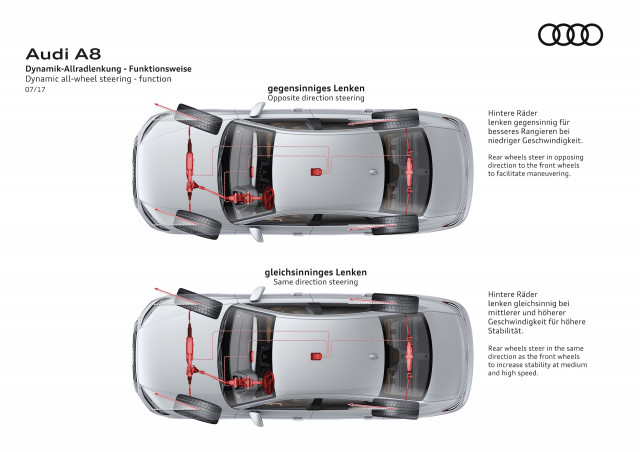2019 Audi A8 first drive review: technology enabling luxury
I’m hustling through the Spanish countryside getting a back massage, attacking roundabouts with gusto in a car that can sprint from 0-60 mph in less than 5.0 seconds, and my passenger is sound asleep. This car does just about everything well. It’s quiet, fast, smooth, spacious, and luxurious. While the car it’s replacing is still quite competitive, this one is clearly a leap forward.
I’m in the 2019 Audi A8 60 TFSI, the V-8-powered, 460-horsepower version of Audi’s flagship that will likely arrive a few months after the V-6 version. It’s a technological tour de force and it doesn’t even have all of the goodies that Audi will eventually bring to the table.

2019 Audi A8’s multi-material spaceframe
Vorsprung durch technik
What enables one car to offer so much capability? As Audi would say, it’s vorsprung durch technik, or advancement through technology.
It starts with the structure and chassis. The A8 no longer uses an aluminum spaceframe (truth be told, it was always steel and aluminum). Audi now employs a multi-media approach. The structure is a combination of high-strength steel, aluminum, magnesium, and even carbon-fiber-reinforced plastic. Through the smart use of these materials, the new structure has 24 percent more structural rigidity than the outgoing spaceframe, and it weighs less, too, though Audi isn’t saying how much. The aluminum content is up to 58 percent, and the carbon fiber and magnesium also help cut weight.

2019 Audi A8

2019 Audi A8

2019 Audi A8

2019 Audi A8
The available suspension technologies are more advanced. The base suspension is an aluminum five-link setup both front and rear with air springs and electrically adjustable dampers. That’s pretty advanced right out of the box. From there, buyers will be able to opt for the 48-volt-powered electromechanical predictive active suspension that uses electric actuators to press the tires into ruts or pull them up over bumps. The system is tied into a forward-looking camera that can see 66 feet ahead and tell the actuators to raise or lower the wheels and body up to 4.3 inches to mitigate the effects of speed bumps, potholes, or other road imperfections.
On top of that, buyers can get rear-axle steering and an active rear differential to help control rear traction out of a turn. Audi's Dynamic All-Wheel Steering is an especially aggressive system that can turn the rear wheels up to 5 degrees opposite the fronts (3 degrees seems to be the industry standard) at speeds up to 37 mph to make the car rotate and shorten the turning circle to a compact car-like 38.7 feet. At over 37 mph, it turns the rear wheels 2 degrees in concert with the fronts to increase highway stability. This system also includes variable ratio steering that ranges between 9.5:1 at low speeds and about 16:1 at high speeds.
The 2019 A8 comes to the U.S. in only the long-wheelbase A8 L body style, which is 5.1 inches longer than the standard sedan. Compared to the outgoing car, it is 1.5 inches longer and sits 0.7 inch higher. At 123.2 inches long, the wheelbase is just 0.2 inch longer.
At launch, we will only see one engine. The A8 L 3.0 TFSI is powered by the twin-scroll turbocharged 3.0-liter V-6 found in Audis like the S5 and SQ5. Here, it produces 335 horsepower and 369 pound-feet of torque. That power is sent through an 8-speed automatic transmission to all four wheels via standard all-wheel drive. Audi quotes a 0-62 mph time of 5.6 seconds.
While it won’t come until perhaps a few months after launch, the U.S. will also get likely offer the twin-turbocharged 4.0-liter V-8 making 460 horsepower and 487 lb-ft of torque. No 0-62 mph number has been given, but expect it to be in the 4.7-second range.
Both engines are considered mild hybrids because they have a 48-volt electrical system with a belt-alternator/starter, a stop/start feature that works below 13.7 mph, a coasting function that shuts the engine off to save fuel between 34 and 99 mph, and brake energy recuperation. U.S. buyers also won't get the coasting feature.
Email This Page